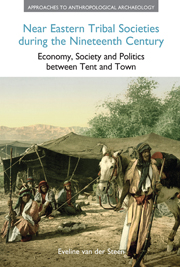 Near Eastern Tribal Societies during the Nineteenth Century
Near Eastern Tribal Societies during the Nineteenth Century Book contents
- Frontmatter
- Dedication
- Contents
- Acknowledgements
- Introduction
- 1 What is a tribe?
- 2 Travellers in the Levant during the nineteenth century
- 3 The dynamics of territorial and power structures
- 4 Oral traditions
- 5 Tribal society and its relation to the landscape
- 6 Tribal institutions
- 7 Relations between the tribes and the state
- 8 From tribe to tribal state: three case studies
- 9 The economy of tribal societies
- 10 Ethnicity and the sense of belonging
- 11 Women in tribal societies
- 12 Religion and folklore
- 13 Back in time: historical parallels
- Notes
- References
- Index
7 - Relations between the tribes and the state
- Frontmatter
- Dedication
- Contents
- Acknowledgements
- Introduction
- 1 What is a tribe?
- 2 Travellers in the Levant during the nineteenth century
- 3 The dynamics of territorial and power structures
- 4 Oral traditions
- 5 Tribal society and its relation to the landscape
- 6 Tribal institutions
- 7 Relations between the tribes and the state
- 8 From tribe to tribal state: three case studies
- 9 The economy of tribal societies
- 10 Ethnicity and the sense of belonging
- 11 Women in tribal societies
- 12 Religion and folklore
- 13 Back in time: historical parallels
- Notes
- References
- Index
Summary
The Queen of Hearts, she made some tarts,
All on a summer's day.
The Knave of Hearts, he stole those tarts,
And took them quite away!
(Lewis Carroll, Alice's Adventures in Wonderland, 1865)Introduction
During most of the nineteenth century the southern Levant and the Arabian Peninsula, although officially part of the Ottoman Empire, were virtually independent. The empire had interests in certain parts of it: the Hajj routes and the seaports. It made an effort to keep the main routes open and the ports profitable, but even that proved hard work at times. The region was controlled by tribes and more or less powerful local rulers. The relationship between them and the empire was mostly economic and political, and tribes, as well as towns, were treated as vassals or allies, rather than as subjects. The state used various tactics that were usually successful in manipulating the tribes, something they preferred to confrontational measures. In conflicts, particularly with the large tribes of the area, the empire did not always come out on top.
Nineteenth-century relationships between the government and the tribes
Areas of control
During most of the nineteenth century the Ottoman Empire had no control over the region south of Salt in Transjordan and south of Hebron in the west, or over most of the Arabian Peninsula. Salt was, in effect, an independent town (Burckhardt 1822: 265; Buckingham 1825: 27, 138; Oliphant 1880: 199). To the north of this area the government had some control, and the smaller tribes in the region north of Salt paid tax. The major tribes and many of the towns considered themselves independent of the government. Desert lands, from Syria in the north to the Arabian Peninsula in the south, were dominated by tribes of the powerful Anaze confederation: the Weld Ali in the north, the Rwala in the Syrian Desert, and the Bashir in the peninsula.
- Type
- Chapter
- Information
- Near Eastern Tribal Societies during the Nineteenth CenturyEconomy, Society and Politics between Tent and Town, pp. 129 - 147Publisher: Acumen PublishingPrint publication year: 2013


